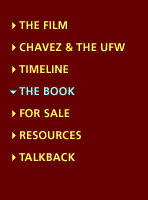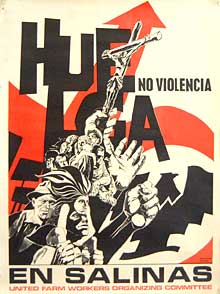 |

Presented by |
 |
 |


Chavez Legacy: He Nurtured Seeds of Art
By Max Benavidez
 Cesar Chavez died with an art book in his hands.
Cesar Chavez died with an art book in his hands.
This final image of the great visionary is appropriate and poetic — because he and his struggle for justice were intimately intertwined with creative expression by Chicano visual and performing artists. The veteran union organizer in him would have appreciated the death-bed image because Chavez intuitively understood the power of symbols.
By the mid-1960s, the United Farm Workers flag, with the black eagle-like thunderbird dramatically set on a background of blood red, conveyed an instant sense of grassroots struggle and cultural pride. Later, he used a banner depicting the Virgen de Guadalupe, the quintessential guardian of the oppressed, when he and the farmworkers went on the famous Pilgrimage to Sacramento. Perhaps it is fitting that Chavez’s own visage has already superseded that of Emiliano Zapata, the beloved peasant leader of the Mexican Revolution, as the paramount Chicano icon.
Chicano art was born in 1965 when Chavez gave budding theater director Luis Valdez permission to mount primitive actos—sketches—on the very picket lines of the Delano fields in California’s Central Valley. In fact, says Valdez, “El Teatro Campesino emerged directly from la huelga—the strike against the growers and agribusiness interests. Visual artists were inspired to join the cause, eventually including a Who’s Who of the genre: Antonio Bernal, Malaquias Montoya, Rupert Garcia, Ester Hernandez. and members of Sacramento’s Royal Chicano Air Force, a socially activist art group of Beat- and Dadaist-influenced painters, poets, and pranksters.
What Chicano art has ultimately become in all its globally hip and often subtle permutations — including the irreverent satire of the comic trio Culture Clash — owes a lot to Chavez and his labor movement. The post-modernist work of Gronk, the often harrowing meditations on existence by the late Carlos Almaraz (who was once an illustrator for the UFW newsletter), the dreamscape paintings of family life by Carmen Lopez Garza, the sardonic conceptual videos of Harry Gamboa Jr., or the big-budget plays and films of Luis Valdez, Chavez influenced them all. It is no exaggeration to say that Chavez was one of Chicano art’s foremost progenitors.
When Chavez told Valdez to make something out of nothing, he was articulating the essence of early Chicano art. In the mid-to-late-sixties, there were no grants, no art degrees; just a burning and sometime indefinable need for artists to say something about themselves and their situation. That was what the work was about then. Now it is displayed in high-priced, fashionably stark galleries, not on decaying street-corner walls. The plays are now performed in state-of-the-art theaters, not on dusty roads. But the work’s roots are far less glamorous. It comes from the smell of the earth, scrawled signs, and the naked will to create under any conditions.
As long as he was alive, Chavez served as a reminder that Chicano creative expression had a moral basis and was founded on the political struggle to overcome oppression. Chavez was an archetype, a bigger-than-life symbol of Chicano art’s distinct origins.
Songwriter Lab Guerrero, himself a legend in the Latino community, remembered traveling up and down the state in the early 1960s. “We went to places Iike Fresno and Stockton and we heard about the organizing that was going on. I became familiar with the farmworkers’ situation. I was very impressed with what Cesar was doing. In 1964 I wrote a corrido, a folk ballad, called ‘El Corrido de Delano." Chavez often remarked that the corrido helped him tremendously.
“I remember the last time I saw him,” Guerrero re-called. “It was in 1992, at a tribute for me in Palm Desert. When he walked into the theater, everything stopped. Quiet. I was amazed to see how everyone stepped aside so he could pass. I got goose bumps. He was revered. Most of the Chicano painters, writers, and actors were very close to the movement. They all found a need to join him.”
One artist who joined him early was Barbara Carrasco. She painted the banners for Chavez’s funeral, which took place in Delano. “I was nineteen when I heard him speak at UCLA,” she reminisced. “I volunteered right after the speech. Cesar told me at the time: ‘We need artists very much.”’ Carrasco started painting banners for the union and has been doing it for fifteen years. In 1989, she was in New York City to unveil her computer-animated billboard, Pesticides, in Times Square. Chavez was also there to promote his campaign against the use of the pesticides in the fields. He held a press conference as Mayor David Dinkins raised the UFW flag over City Hall. “Cesar was very interested in the billboard and wanted to know how the computer animation worked,” Carrasco said. “He was surprised to learn that the animation would run for a whole month. The timing was perfect. It showed a farmworker picking grapes and being sprayed by a crop duster. Then the grapes are shown in a supermarket where a woman buys them and takes them home to her children. The children eat them and become ill. The animation ends with calaveras—skulls—the symbol of death, as the crop duster comes down on the farmworker again.”
Chavez lived to witness Chicano art as it evolved from simple agitprop in the open fields to a computer-driven image among the big city lights of Times Square.
In death, Chavez has become a mythic figure. For the Chicano community, his posthumous image will resonate long into the next century as a symbol of strength and creativity. He will appear in poems, songs, and films. He will become a reflection of the organic nature of Chicano art and its powerful origins as a synthesis of the spirit, culture, and politics. The Chavez legacy will inspire artists for decades to come. As an art lover, he would have liked that.
Max Benavidez is a Los Angeles essayist, critic and poet who has written widely about Chicano art and culture.
Used with the permission of the author. Copyright Max Benavidez
|
  |

